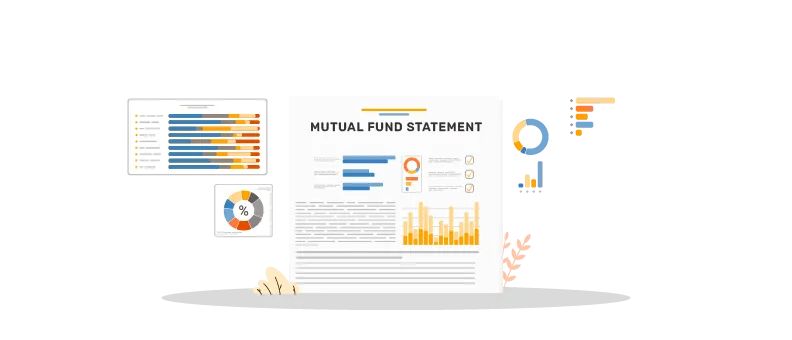Mistakes to avoid when reading your mutual fund statement


Your mutual fund statement is a detailed document that provides information related to your investments. Asset management companies (AMCs) or fund houses that offer mutual funds are required by law to provide investors with fund statements upon request for any time period. Thus, the mutual fund statement can be accessed 24/7 on the AMC website. Although each AMC may use a slightly different structure and layout for their mutual fund statements, the essential information is always the same.
- Table of contents
Common mistakes to avoid when reading your mutual fund statement
Verify the Personal Details
First and foremost, you should verify that your name is mentioned correctly in the fund document. Next, verify the address and report any disparity immediately to the mutual fund distributor or relationship manager.
Check Banking Information
Verify there are no typos and that all the information – including your bank's name, account number, PAN, and IFSC code – is correct. This is especially relevant if you want to redeem your investment or if you have registered for a Systematic Investment Plan (SIP).
Check KYC Status
The KYC status must show ‘OK’; if not, complete the process right away. For compliance purposes and to have access to financial services, it is essential that the KYC status indicates ‘OK’. To prevent any delays or disturbances, make sure that any inconsistencies are immediately corrected.
Report Discrepancies
Notify the fund house immediately if there are any discrepancies in information. Failing to do so could potentially impact your investment goals. It's crucial to ensure accuracy to safeguard your investment portfolio.
Assess Transaction Summary
Pay attention to the dates, amounts, NAVs (Net Asset Value), and units bought/sold. Verify if transactions align with your investment strategy.
Monitor Portfolio Holdings
Evaluate any significant changes in holdings that may have shifted from your original allocation.
Add a Nominee
This is important to ensure a smooth transfer of assets in case of an unfortunate event. It's vital for safeguarding your financial legacy and ensuring that your assets are seamlessly passed on to your chosen beneficiary when needed.
Exit Load
Remember that the exit load that applies upon redemption is the one that was in place at the time the investment was made, not the mutual fund's current exit load structure.
Read Also: Key terms in your mutual fund statement
Conclusion
You need to carefully review your mutual fund statements the same way as you do with your bank and credit card accounts. Report a disparity to the mutual fund company if you find one. Verify whether your PAN card has been updated in the portfolio. The consolidated mutual fund statement provides you with an overview of your portfolio by revealing how much has been invested and in which scheme. By understanding the key sections and focusing on relevant information, you can stay on top of your investments and potentially achieve your financial goals.
FAQs
How do you read a mutual fund statement?
To read a mutual fund statement, start with the summary section for key details like account balance and performance. Check the fund's performance over different time frames, review individual transactions, understand your holdings, and note any fees or charges.
How often should I review my mutual fund statement?
Ideally, you should review your mutual fund statement at least once every quarter to stay informed about your investment's performance, transactions, and any changes in fees. Depending on your investment goals and preferences, you may choose to review it more frequently, such as monthly.
What is a mutual fund statement?
A mutual fund statement is a summary of all your mutual fund transactions, including SIPs, lumpsum payments, redemptions, and more. It provides an overview of your mutual fund investments and their performance.
What are the common mistakes that investors make when they invest in mutual funds?
Common mutual fund investment mistakes include investing without clear goals, ignoring risk tolerance, chasing past performance, over/under-diversification, neglecting fees, emotional investing, failing to review portfolios, lack of research, ignoring taxes, and focusing on short-term gains. Avoiding these pitfalls and conducting thorough research helps achieve long-term investment goals.
Are there any risk related to mutual fund investments?
While mutual funds offer advantages, they come with risks. These include market risk (equity and debt fund fluctuations), fund manager risk (poor decisions or strategy changes), concentration risk, liquidity risk, high expense ratios , tax implications, and the lack of guaranteed returns. Thorough research and caution are essential in managing these risks.
What factors should I keep in mind before investing in mutual funds?
Before investing in mutual funds, consider these key factors: define your investment goals (e.g., retirement or education), assess your risk tolerance, and choose a suitable fund type (equity, debt, hybrid). Research funds carefully, diversify your portfolio, and consider starting with a SIP. Regularly monitor and rebalance, and seek professional advice to tailor your investments.
What is the biggest risk of investing in mutual funds?
One of the biggest risk of investing in mutual funds is market risk, caused by market fluctuations due to economic downturns, political instability, or unforeseen events. Diversification can reduce some risks, but market risk remains inherent in all types of investments.
What is the best strategy for investing in mutual funds?
The best mutual fund investment strategy depends on personal factors such as investment goals, risk tolerance, time horizon, and financial situation. Key principles include defining clear goals, assessing risk tolerance, diversifying, focusing on long-term investing, using SIPs, and regularly reviewing and rebalancing. Always seek professional advice.
How should I approach investing in mutual funds compared to individual stocks?
Mutual funds offer diversification, professional management, and lower investment thresholds, but come with management fees and limited control. Individual stocks offer higher potential returns and more control, but involve higher risk and require extensive research. Beginners should start with mutual funds, while experienced investors may combine both based on risk tolerance.
Is a mutual fund with a lower NAV better than one with a higher NAV?
A mutual fund's NAV does not directly indicate its quality. It’s just a snapshot and can fluctuate with market conditions. Focus on the fund’s long-term performance, the manager’s expertise, investment strategy, expense ratio, and risk profile. Thorough research and considering these factors are essential for making informed decisions.
Related Searches:
Mutual Fund investments are subject to market risks, read all scheme related documents carefully.
This document should not be treated as endorsement of the views/opinions or as investment advice. This document should not be construed as a research report or a recommendation to buy or sell any security. This document is for information purpose only and should not be construed as a promise on minimum returns or safeguard of capital. This document alone is not sufficient and should not be used for the development or implementation of an investment strategy. The recipient should note and understand that the information provided above may not contain all the material aspects relevant for making an investment decision. Investors are advised to consult their own investment advisor before making any investment decision in light of their risk appetite, investment goals and horizon. This information is subject to change without any prior notice.
Mutual Fund investments are subject to market risks, read all scheme related documents carefully.
This document should not be treated as endorsement of the views/opinions or as investment advice. This document should not be construed as a research report or a recommendation to buy or sell any security. This document is for information purpose only and should not be construed as a promise on minimum returns or safeguard of capital. This document alone is not sufficient and should not be used for the development or implementation of an investment strategy. The recipient should note and understand that the information provided above may not contain all the material aspects relevant for making an investment decision. Investors are advised to consult their own investment advisor before making any investment decision in light of their risk appetite, investment goals and horizon. This information is subject to change without any prior notice.
The content herein has been prepared on the basis of publicly available information believed to be reliable. However, Bajaj Finserv Asset Management Ltd. does not guarantee the accuracy of such information, assure its completeness or warrant such information will not be changed. The tax information (if any) in this article is based on prevailing laws at the time of publishing the article and is subject to change. Please consult a tax professional or refer to the latest regulations for up-to-date information.